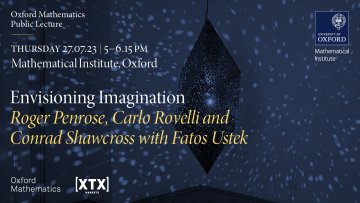Imagination is the creative force for artists. But what about mathematicians and scientists? What part does imagination play in their work? What do the artist and the scientist have in common? And how do each envision things that will never be seen?
In this panel discussion two scientists and one artist, all leaders in their field, will provide an answer. They have more in common than you would think.
Sequence models in biomedicine: from predicting disease progression to genome editing outcomes
Abstract
Sequential biomedical data is ubiquitous, from time-resolved data about patient encounters in the clinical realm to DNA sequences in the biological domain. The talk will review our latest work in representation learning from longitudinal data, with a particular focus on finding optimal representations for complex and sparse healthcare data. We show how these representations are useful for comparing patient journeys and finding patients with similar health outcomes. We will also venture into the field of genome engineering, where we build models that work on DNA sequences for predicting editing outcomes for base and prime editors.
The generalist medical AI will see you now
Abstract
Accurate interpretation of medical images is crucial for disease diagnosis and treatment, and AI has the potential to minimize errors, reduce delays, and improve accessibility. The focal point of this presentation lies in a grand ambition: the development of 'Generalist Medical AI' systems that can closely resemble doctors in their ability to reason through a wide range of medical tasks, incorporate multiple data modalities, and communicate in natural language. Starting with pioneering algorithms that have already demonstrated their potential in diagnosing diseases from chest X-rays or electrocardiograms, matching the proficiency of expert radiologists and cardiologists, I will delve into the core challenges and advancements in the field. The discussion will navigate towards the topic of label-efficient AI models: with a scarcity of meticulously annotated data in healthcare, the development of AI systems capable of learning effectively from limited labels has become a key concern. In this vein, I'll delve into how the innovative use of self-supervision and pre-training methods has led to algorithmic advancements that can perform high-level diagnostic tasks using significantly less annotated data. Additionally, I will talk about initiatives in data curation, human-AI collaboration, and the creation of open benchmarks to evaluate the generalizability of medical AI algorithms. In sum, this talk aims to deliver a comprehensive picture of the state of 'Generalist Medical AI,' the advancements made, the challenges faced, and the prospects lying ahead.
Mathematical modelling identifies serum hepatitis B RNA as an informative biomarker of anti-viral treatment efficacy
Abstract
Chronic hepatitis B virus (HBV) infection leads to liver damage that increases the risk of hepatocellular carcinoma and liver cirrhosis. Individuals with chronic HBV infection are often either treated with interferon alpha or nucleoside reverse transcriptase inhibitors (NTRL). While these NTRLs inhibit de novo DNA synthesis, they do not represent a functional cure for chronic HBV infection and so must be taken indefinitely. The resulting life-long treatment leads to an increased risk of selection for treatment resistant strains of HBV. Consequently, there is increased interest in a novel treatment modality, capsid protein allosteric modulators (CPAMs), that blocks a crucial step in the viral life cycle. I'll discuss recent work that identifies HBV serum RNA as an informative biomarker of CPAM treatment efficacy, evaluates CPAMs as a potential functional cure for HBV infection, and illustrates the role of mechanistic modelling in trial design using an age structured, multi-scale mathematical model.


